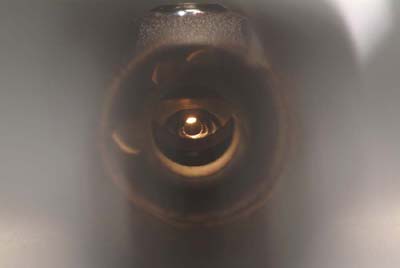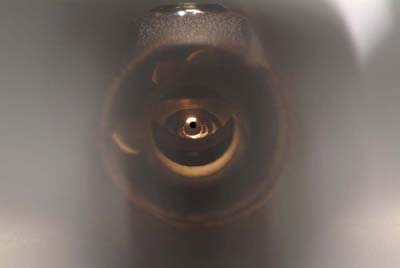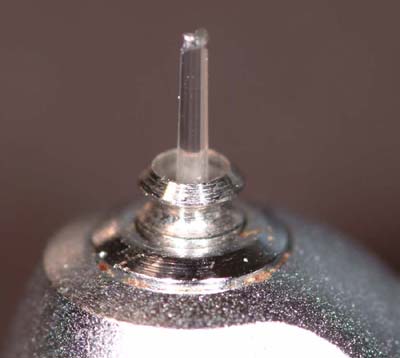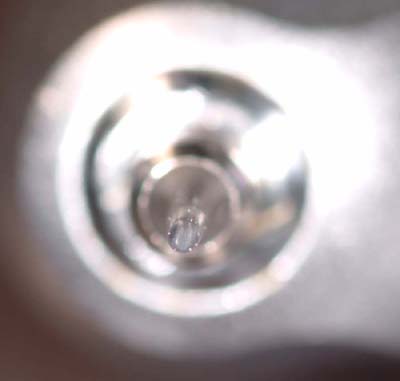Forums › Erbium Lasers › General Erbium Discussion › Decay around amalgam
- This topic is empty.
-
AuthorPosts
-
greg holmSpectatorI always appreciate your pics Glen. Was that fiber damaged by this proceedure? Is there an electrical current or something generated here?
Greg
Glenn van AsSpectatorYes the tip is not as good anymore , I think that the scatter back from the amalgam damages the tip. It does squat to the amalgam but it does damage the tip.
Maybe Bob can explain why but the bottom line is dont do it!!Thanks for the compliments, if my pics help a few people “See the Light” ( pun intended) than I guess it is all worth while.
Glenn
2thlaserSpectatorGlenn,
you are right, Bob probably knows for sure. When you point a laser pointer at a reflective surface, what happens? The same HAS to happen to our wavelengths I would think. Energy is directed BACK into the tip, thereby ruining it. If we (Biolase users) still use the tip to finish, once it is “spoiled”, we can blow our fibers. What about your DeLight? Does that happen to your laser? The reason Biolase lasers blow trunk fibers when that happens is in the mirror in the end of the handpiece. The mirror becomes “blackend” and the laser engery then “overloads” the trunk fiber, and then WHAMMO, good bye!
Here is what the mirror looks like as you look through the end of the handpiece…
Here’s what it looks like after it’s “blacked” by using a spoiled tip….(hope I got these right!)

Hope this helps the Waterlase users! We should add this post to the Maintenance page Ron, can you do that?
Mark
2thlaserSpectatorPS…looks like it was an accurate post of pictures. MAKE SURE YOU LOOK THROUGH THE END OF THE HANDPIECE WITH MAGNIFICATION. It is the ONLY way you can really see this.
Mark
Glenn van AsSpectatorIt doesnt do anything to the Continuum……..my fiber has been working for almost 3 years.
Glenn
SwpmnSpectatorIn my opinion, this thread and subsequent replies are some of the most significant yet posted on the Forum. This thread and photos should be printed and saved by anyone using or considering purchase of a “hard tissue” Erbium laser.
Use of the Erbium around metals and old metal-containing bases/restorations damages the laser “tips”. In the case of some Erbiums it also damages the reflective mirror in the “head” of the “handpiece”. Damage to the mirror results in eventual failure of the trunk fiber delivery system – my technician explained this to me after my last trunk fiber failure. I’ve suspected this for over a year but finally have some official confirmation.
And it’s not just as simple as avoiding usage of the laser around amalgam or PFM crown margins. I notice “sparking” on removal of old composites and old bases/liners. Until you begin removal, there is no way to predict whether the old composite/base/liner will cause sparking. With mirrored handpiece systems, if you see sparking, you can be assured you are causing damage to the tip, mirror and eventually the trunk fiber delivery system.
Dr. Colonna has done us a great service by providing the first photos I have seen which document damage to a mirrored handpiece delivery system. Those who use or are considering purchase of such systems would be wise to print these photos and check your handpieces on a regular basis.
Al
Glenn van AsSpectatorHi Allen: I did that decay around the amalgam last week and here are three pics of my fiber window that I shot today. There are air holes and water holes but no damage to the window there.
Glenn
[img]https://www.laserdentistryforum.com/attachments/upload/Resize of DSCN5044.JPG[/img]
[img]https://www.laserdentistryforum.com/attachments/upload/Resize of DSCN5045.JPG[/img]
[img]https://www.laserdentistryforum.com/attachments/upload/Resize of DSCN5042.JPG[/img]
SwpmnSpectatorThat’s pretty cool, Glenn. So the tip just pops right into the end of the fiber?
How much did that burned out tip set you back?
Al
2thlaserSpectatorAlso Glenn, is there a mirror to “foul” in your handpiece? As we have a mirror in ours to deflect the laser energy out the tip at a 90 degree angle. Here is a picture of a “fouled” tip.

You can also see the angle, like a bur in a high speeds angle, the tip exits from the handpiece. Disadvantage, mirror, advantage, feels like regular dental handpiece, which alot of people like. I personally would love to have both a straight and the conventional laser handpiece (hopefully Biolase reads this board huh?)
Mark
greg holmSpectatorDo you take those pics thru a microscope Mark, like Glen does. They are awesome!
So, the strait tip handpiece of continuum delight is less subject to amalgam damage than the 90deg handpiece of waterlase?
Greg
2thlaserSpectatorGood question Greg. Glenn? I am not sure. As far as photo’s, I am using a Fujifinpix S-2 digital camera, it is really great. I wouldn’t be without it! Ross Nash turned me on to it, I can’t thank him enough!
SwpmnSpectatorMan, is this not the coolest thread or what? We gotta get the word out so people can see these images.
I don’t know jack about engineering, but I’m going to go out on a limb and propose a theory:
Biolase developed a “handpiece” delivery system because they knew this would feel very familiar to dentists. If anyone ever looked at the ADT Cavilase it was developed similarly with a “handpiece”. Problem is, you can’t bend a trunk fiber 90 degrees, so Biolase put a mirror in the “head” of the handpiece to reflect the laser beam down the tip and into the treatment area.
Unfortunately, the mirror gets burned or pitted when one touches a metal-containing restoration/base/liner because as Mark said, the laser energy is reflected back up the tip and onto the mirror. As the dentist continues to use the instrument, the outgoing laser energy hits the damaged mirror and is reflected back into the trunk fiber, thus resulting in trunk failure.
But why use a “handpiece” mirrored delivery system at all? The shape of the handpiece casing is what was designed in the 1950’s to contain air turbines or the same as is now used in electric handpieces for gears. I don’t like the laser “handpiece” because it is hard for me to see around the “head” – particularly because it is set at 90 degrees unlike modern air/electric handpieces.
Crawling further out on the limb:
Glenn’s ConBio DeLight trunk fiber does not fail because there is no mirror(although there is an optional “handpiece”). Glenn uses a “pen-like” delivery system, looks similar to an electro/radiosurge unit(he showed me diagrams). I propose that in the ConBio DeLight the trunk fiber does not fail because there is no mirror and the tip acts like a “shear pin” or “weakest link”. When the tip is damaged there will be a reduction in cutting efficiency but no mirror-reflected damage back into the trunk fiber.
Just a crazy theory. Ya’ll let me know what you think and let’s continue this great dialogue!
Al
2thlaserSpectatorAl,
I am with you on this one. I think you are absolutely correct as far as the Biolase design, and reasons behind it. I have seen a straight handpiece they have developed, but don’t know if there is a mirror in it. I would think there isn’t, wouldn’t make sense to need one. I know I would use the straight handpiece quite often. I don’t think that the energy from a pitted or blackend mirror reflects back, but instead, the energy has no where to go, so IT backs up, heats up, and then the fiber goes. I will find out from Andy, as I will see him in Salt Lake on Friday during my lecture, and I promise I will get back to all of you then. You are right, great thread!
Mark
2thlaserSpectatorHere is a picture of a tip, that has a split starting at about 8 o’clock, it runs from the edge of the tip to the inside edge. Very hard to see without magnification. THESE are the tough ones to see, shine your operatory light through them, that seems to help. (like transillumination).

Mark
SwpmnSpectatorMark:
That makes a ton of sense about a damaged mirror – laser energy backs up and burns out the trunk fiber. Personally I also believe it damages the internal components of the Erbium because I’ve had to have mine completely “overhauled”.
But I don’t want a “straight handpiece”. What I need is a 30 to 45 degree angled fiber end with a removable tip. I’ve contacted ConBio for more information and will look at the product in April at the California Dental Association Spring Session.
Keep us posted on what you learn.
Al
-
AuthorPosts
